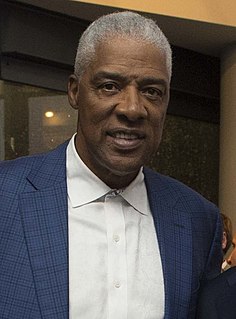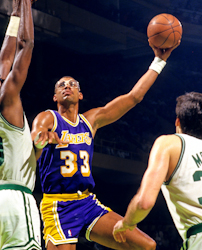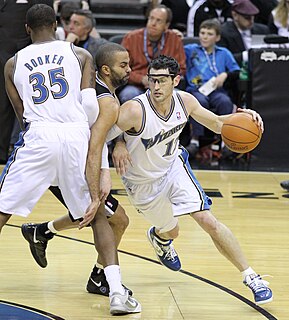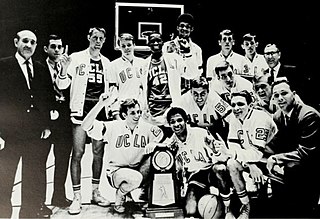
A slam dunk, also simply dunk, is a type of basketball shot that is performed when a player jumps in the air, controls the ball above the horizontal plane of the rim, and scores by putting the ball directly through the basket with one or both hands above the rim. It is considered a type of field goal; if successful, it is worth two points. Such a shot was known as a "dunk shot" until the term "slam dunk" was coined by former Los Angeles Lakers announcer Chick Hearn.

Julius Winfield Erving II, commonly known by the nickname Dr. J, is an American former professional basketball player. Regarded as one of the greatest and most influential basketball players of all time and the greatest ABA player of all time, Erving helped legitimize the American Basketball Association (ABA) and was the best-known player in that league when it merged into the National Basketball Association (NBA) after the 1975–76 season.

William Felton Russell is an American former professional basketball player who played as a center for the Boston Celtics of the National Basketball Association (NBA) from 1956 to 1969. A five-time NBA Most Valuable Player and a 12-time All-Star, he was the centerpiece of the Celtics dynasty that won eleven NBA championships during his 13-year career. Russell and Henri Richard of the National Hockey League are tied for the record of the most championships won by an athlete in a North American sports league. Russell led the San Francisco Dons to two consecutive NCAA championships in 1955 and 1956, and he captained the gold-medal winning U.S. national basketball team at the 1956 Summer Olympics.

The center (C), also known as the five, is one of the five positions in a basketball game. The center is normally the tallest player on the team, and often has a great deal of strength and body mass as well. In the NBA, the center is around 7 feet (2.13 m) tall. They traditionally have played close to the basket in the low post.

Jason Anthoney Richardson is an American former professional basketball player who played 14 seasons in the National Basketball Association (NBA). Richardson was taken by the Golden State Warriors as the fifth overall pick in the 2001 NBA draft after playing college basketball for Michigan State University. He won the NBA Dunk Contest in both 2002 and 2003, becoming the second player, after Michael Jordan, to win the competition back-to-back. Richardson has also played for the Charlotte Bobcats, Phoenix Suns, Orlando Magic, and the Philadelphia 76ers. Jason is often remembered for his dunking ability, and had signature 360 in game dunk but he is rarely remembered for his high shooting percentage.

David O'Neil Thompson is an American former professional basketball player. He played with the Denver Nuggets of both the American Basketball Association (ABA) and National Basketball Association (NBA), as well as the Seattle SuperSonics of the NBA. He was previously a star in college for North Carolina State, leading the Wolfpack to its first NCAA championship in 1974. Thompson is one of the six players to score 70 or more points in an NBA game. Thompson was inducted into the Naismith Basketball Hall of Fame in 1996.

The pick and roll in basketball is an offensive play in which a player sets a screen (pick) for a teammate handling the ball and then moves toward the basket (rolls) to receive a pass. In the NBA, the play came into vogue in the 1990s and has developed into the league's most common offensive action. There are however many ways in which the defense can also counter the offensive screen.
Basketball moves are generally individual actions used by players in basketball to pass by defenders to gain access to the basket or to get a clean pass to a teammate to score.
The 1977 NBA World Championship Series was the championship round of the National Basketball Association (NBA)'s 1976–77 season, and the culmination of the season's playoffs. The Western Conference champion Portland Trail Blazers played against the Eastern Conference champion Philadelphia 76ers, with the 76ers holding home-court advantage. Their four regular season meetings had been split evenly, 2–2, with neither side winning away from home. The series was played under a best-of-seven format.

This glossary of basketball terms is a list of definitions of terms used in the game of basketball. Like any other major sport, basketball features its own extensive vocabulary of unique words and phrases used by players, coaches, sports journalists, commentators, and fans.
Raleigh Climon Owens was a professional American football end and halfback from 1957 through 1964. Owens graduated from Santa Monica High School in Santa Monica, California, and attended the College of Idaho. He played amateur basketball with the Seattle-based Buchan Bakers the year after their national championship.

The 1983 NCAA Division I Men's Basketball Tournament involved 52 schools playing in single-elimination play to determine the national champion of men's NCAA Division I college basketball. It began on March 17, 1983, and ended with the championship game on April 4 at The Pit, then officially known as University Arena, on the campus of the University of New Mexico in Albuquerque. A total of 51 games were played.
The 1977 NBA playoffs was the postseason tournament of the National Basketball Association's 1976–77 season. The tournament concluded with the Western Conference champion Portland Trail Blazers defeating the Eastern Conference champion Philadelphia 76ers 4 games to 2 in the NBA Finals. It was Portland's first NBA title. Bill Walton was named NBA Finals MVP.

The alley-oop is an American football play in which the quarterback throws the ball high into the air, and another player jumps up and catches it. The play was developed in 1957 by San Francisco 49ers players Y. A. Tittle and R. C. Owens. The play was named after V. T. Hamlin's comic strip character Alley Oop; Owens himself was also known as "Alley Oop". It was highly successful when utilized due to Owens' 6 ft 3 in height and ability to out-leap defenders.

The 1966–67 UCLA Bruins men's basketball team won UCLA's third NCAA National Championship under head coach John Wooden with a win over Dayton. The Bruins went undefeated, winning all thirty games.
The 1982–83 NC State Wolfpack men's basketball team represented North Carolina State University. The Wolfpack were a member of the Atlantic Coast Conference (ACC). The team went 26–10 on the year, winning the ACC Tournament and the NCAA National Championship.
A give-and-go, or one-two, is a fundamental maneuver in many team sports which involves two players passing the ball or puck back and forth. The player who has the ball or puck passes to a teammate and then repositions in order to receive a return pass and possibly create a scoring opportunity.
Basketball is a ball game and team sport in which two teams of five players try to score points by throwing or "shooting" a ball through the top of a basketball hoop while following a set of rules. Since being developed by James Naismith as a non-contact game that almost anyone can play, basketball has undergone many different rule variations, eventually evolving into the NBA-style game known today. Basketball is one of the most popular and widely viewed sports in the world.
The 1983 NCAA Division I Men's Basketball Championship Game was the final game of the 1983 NCAA Division I Men's Basketball Tournament. It determined the national champion for the 1982–83 NCAA Division I men's basketball season. The game was played on April 4, 1983, at The Pit in Albuquerque, New Mexico and paired top-ranked, #1 seed Midwest Regional Champions, the Houston Cougars, and sixteenth-ranked, #6 seed West Regional Champions, the NC State Wolfpack.
"Havlicek stole the ball" is a quote by radio broadcaster Johnny Most, as a jubilant reaction to a steal made by the Boston Celtics' John Havlicek against the Philadelphia 76ers in the 1965 NBA Eastern Division championship game seven. Most's call of the play has been dubbed by the NBA as "the most famous radio call in basketball history."














